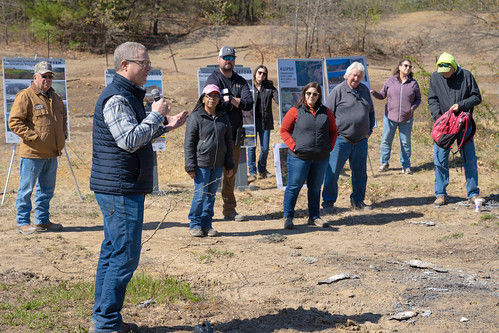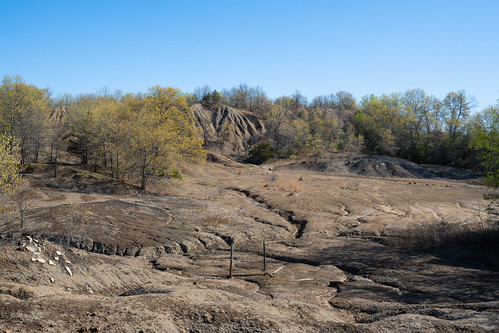Marion County, Iowa, has a long history with soil and water conservation work. This county was the first in Iowa to put together a soil and water conservation district and held its first National Soil Conservation Day in 1946.
 That spirit of conservation has carried on to this day through the efforts of the Iowa Department of Agriculture and Land Stewardship. On May 2, the department hosted a field day at an abandoned mine site in Marion County. The event, held in celebration of “Stewardship Week,” introduced an up-and-coming reclamation project to stakeholders and community members.
That spirit of conservation has carried on to this day through the efforts of the Iowa Department of Agriculture and Land Stewardship. On May 2, the department hosted a field day at an abandoned mine site in Marion County. The event, held in celebration of “Stewardship Week,” introduced an up-and-coming reclamation project to stakeholders and community members.
Attendees got a chance to tour the barren piles of discarded soil and an unnaturally blue pond full of toxic metals like aluminum. The project, which is in the early stages, brings together Iowa Agriculture’s Mines and Minerals Bureau reclamation staff, program specialists from the Office of Surface Mining Reclamation and Enforcement, nonprofit partners from Pathfinders RC&D, and design expertise from contractors.
The abandoned surface mine sits on 84 acres of privately owned land, where two farmers frequently graze cattle. Deer and cow tracks can be seen imprinted in the thick mud between barren mounds of dirt and rock.
 The site was mined from the 1930s to the 1960s, after which it was abandoned with no efforts to clean up or restore the dangerous features. Some of these features include 2,500 feet of dangerous highwalls, 52 acres of piles and embankments, 8 pit ponds, industrial and residential waste, and a sediment-filled pond that can swallow up whomever steps in with thigh-deep mud. “This bare spoil material is highly acidic, washing downstream into our waterways. Iowa really pushes for clean water, and these sites are a big roadblock to that goal,” says Ryan Starkey, project lead for the Kuiper site.
The site was mined from the 1930s to the 1960s, after which it was abandoned with no efforts to clean up or restore the dangerous features. Some of these features include 2,500 feet of dangerous highwalls, 52 acres of piles and embankments, 8 pit ponds, industrial and residential waste, and a sediment-filled pond that can swallow up whomever steps in with thigh-deep mud. “This bare spoil material is highly acidic, washing downstream into our waterways. Iowa really pushes for clean water, and these sites are a big roadblock to that goal,” says Ryan Starkey, project lead for the Kuiper site.
Although Iowa closed its last active coal mine a number of years ago, abandoned mines are still littered throughout the state, posing a risk to the community and the environment. Most abandoned coal mines in Iowa reside on private property, and while landowners are not required to reclaim the land, many are eager for the chance to clean up the water and soil.
Project Funding
Getting these abandoned mines cleaned up is a massive undertaking which requires significant resources. The Infrastructure Investment and Jobs Act, otherwise known as the Bipartisan Infrastructure Law, passed in November of 2021, has allocated $11.3 billion over 15 years to OSMRE’s Abandoned Mine Lands program. This project is one of the first in the country to use the historic funding.
 “Historically, Iowa has been a minimum program state, which means it'd be very difficult on our usual budget of $2.9 million to fund a project this size. The addition of the BIL funds really allows us to tackle these large-scale projects that are over 80 acres,” emphasizes Starkey.
“Historically, Iowa has been a minimum program state, which means it'd be very difficult on our usual budget of $2.9 million to fund a project this size. The addition of the BIL funds really allows us to tackle these large-scale projects that are over 80 acres,” emphasizes Starkey.
This project is still in the design phase, after which the state will gather environmental information for OSMRE to make sure everything is compliant with the National Environmental Policy Act. It is tentatively scheduled to go to construction bid in August of 2024, with a construction contract through December of 2025. After the project is completed, it will be monitored over the course of several years to make sure everything continues to work as planned.
Reclamation Process
Currently, Iowa’s reclamation specialists predict that the Kuiper project will use a combination of conventional and blended reclamation techniques. Conventional methods include terracing to prevent erosion and traditional drainage infrastructure, as well as constructed wetlands to treat acid mine drainage. “This aqua-blue coal mine pit pond is acidic and nothing's growing in it. When you drain that water out and add limestone to the soil, you treat that acidity,” says Wally Greenlees, an engineer with the Iowa Department of Agriculture.
The design will also naturally regrade the valleys into the surrounding landscape and follow the meandering curvature of the existing stream. On the eastern end, the team is looking at using the timbered area for wildlife habitat restoration, while the western side will be focused on creating grazing pasture for the landowners.
 “We're able take a scarred landscape and transform it into something that's gentler, flatter, more usable,” says Greenlees. “It'll never be good Iowa farmland again, at least not in our lifetime. But it'll support grass, and with the proper management, it'll be useful again.”
“We're able take a scarred landscape and transform it into something that's gentler, flatter, more usable,” says Greenlees. “It'll never be good Iowa farmland again, at least not in our lifetime. But it'll support grass, and with the proper management, it'll be useful again.”
Calvin Van Genderen, a farmer from Wapello County, had a similar reclamation project done on his property several years ago, and recounted seeing wildlife return in the following years. “We have just hundreds of geese, all different kinds, swimming in our pond now.”
“What I find the most amazing is the existence of amphibious wildlife,” adds Greenlees. “You hear frogs, which you didn't hear before. The water is so much better for them, and the habitat is improved. The transformation is fabulous, and it’s one of my favorite parts about this job.”
See the video below for more about this event.
Audio Description Version

